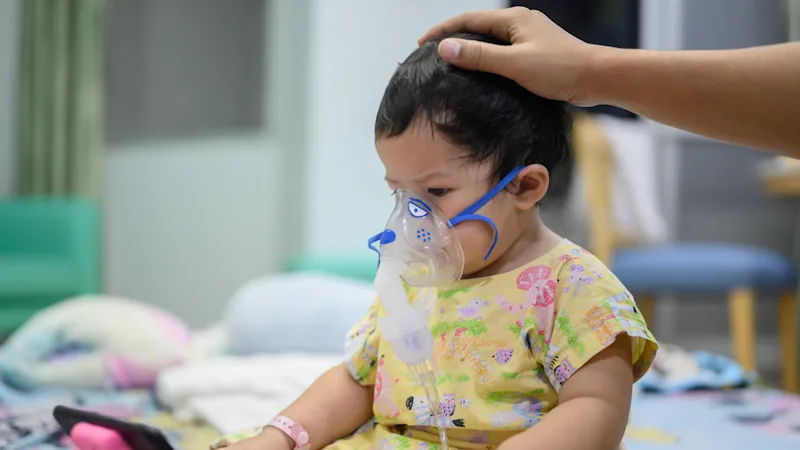Welcome back to our second article in this essential series designed to equip new and expecting parents with the knowledge they need to navigate pediatric viruses, allergies, and Respiratory Syncytial Virus (RSV). In our first article, we provided insights into differentiating viral and bacterial infections and when to consult a healthcare provider. Today, we'll demystify the differences between allergies and viral infections, dive deep into RSV, and list the crucial signs you should never ignore.
To watch the complete RSV webinar session with Dr. Steven Goudy, please click here.
Allergies vs. Viral Infections in Children

When your little one has a constant runny nose or seems congested, it's easy to suspect allergies. However, these symptoms are often a sign of a lingering viral infection, especially if your child goes to daycare. Viral infections usually last around 7 to 10 days and present symptoms like fever, congestion, and coughing in phases. Interestingly, symptoms often worsen at night. Let's breakdown the differences.
Allergies
- Cause: Allergies are caused by an overreaction of the immune system to specific substances that are harmless to most people, such as pollen, dust mites, or certain foods.
- Duration: Allergic symptoms can last as long as the person is exposed to the allergen and may continue for a prolonged period if the exposure is ongoing.
- Symptoms: Common symptoms include sneezing, runny or stuffy nose, itchy or watery eyes, and skin rashes. Some people may also experience difficulty breathing or anaphylaxis in severe cases.
- Treatment: Allergies are generally treated with antihistamines, nasal sprays, and other medications that help control symptoms. Allergen avoidance or immunotherapy are other long-term strategies.
- Infectiousness: Allergies are not contagious and cannot be passed from one person to another.
- Fever: Allergies generally do not cause a fever.
Viral Infections
- Cause: Viral infections occur when a virus enters the body and invades healthy cells to reproduce, which can lead to illness.
- Duration: A viral infection usually has a finite course, often lasting from a few days to a couple of weeks, depending on the virus and the individual's immune system.
- Symptoms: Symptoms can range from mild to severe and may include fever, fatigue, coughing, and body aches. In some cases, viral infections can lead to more serious complications like pneumonia.
- Treatment: There are antiviral medications for some infections, but many viral infections simply have to run their course. Symptom relief through over-the-counter medications, rest, and hydration are common treatment strategies.
- Infectiousness: Viral infections are generally contagious and can be spread through various means, such as direct contact, airborne transmission, or bodily fluids.
- Fever: Fever is a common symptom of viral infections but is generally not present in allergies.
"In summary, allergies are an immune system response to harmless substances and are chronic, whereas viral infections are caused by viruses and are acute but generally self-limiting. Treatments and precautions will vary significantly depending on whether symptoms are due to an allergy or a viral infection, making it crucial to understand the difference between the two." said Goudy.
How to Manage Viral Infections in Babies
Managing viral symptoms can be a daunting task. While over-the-counter treatments can't cure the infection, home remedies like maintaining nasal hygiene and using a humidifier can alleviate discomfort. Here are two top rated humidifiers for your nursery:
Also, keep an eye out for symptoms of dehydration and respiratory distress. A steamy shower might offer temporary relief by opening up congested airways.
RSV: What Every Parent Needs to Know

RSV or Respiratory Syncytial Virus is a winter villain notorious for causing severe respiratory distress, especially in babies aged six to nine months. Distinguishing RSV from other common viruses like rhinoviruses is crucial because RSV often results in excessive mucus in both upper and lower respiratory tracts.
Warning Signs of Severe Infections
If your child experiences high fevers, seems lethargic, shows rapid or labored breathing, or exhibits signs of dehydration, don't hesitate to contact your healthcare provider right away. Watch out for 'retractions'—when skin pulls in at the base of the neck or under the ribs—as it's a sign of significant respiratory distress.
Here's an Instagram video that shows you the difference between typical breathing and labored breathing in babies.
Risk of Dehydration from Rapid Breathing
Rapid breathing can exacerbate dehydration. Panting not only prevents your child from taking in sufficient fluids but also leads to fluid loss through the humidified air they breathe out. Maintaining proper hydration is critical during any viral infection.
The Role of Your Pediatric Care Provider
As Dr. Goudy emphasizes, a good relationship with your pediatric care provider can be your best asset when navigating your child's health. They can provide personalized advice and guidelines on when to seek further medical intervention. Websites like the American Academy of Pediatrics and the American Academy of Family Physicians offer reliable information for concerned parents.
Additional Resources:
- Buy the NozeBot by Dr. Noze Best: The NozeBot offers 3 levels of pediatrician-approved suction, to give your baby instant relief from snotty noses.
- Read Blog: How Do Seasonal Allergies Differ Between Babies and Toddlers
- Read: 6 Foods That Help Calm Seasonal Allergies (That Even Your Toddler Will Love)
- Follow Dr. Noze Best on Instagram and TikTok
- Buy Baby 411 Book by Pediatrician Dr. Brown and owner of 411 Pediatrics in Austin, Texas
.png)
Disclaimer: All material on this website is provided for your information and education only and may not be construed as medical advice or instruction. No action or inaction should be taken based solely on the contents of this information; instead, readers should consult appropriate health professionals on any matter relating to their health and well-being. This information isn’t intended to diagnose, treat, cure, or prevent any condition or disease, nor is it medical advice.


